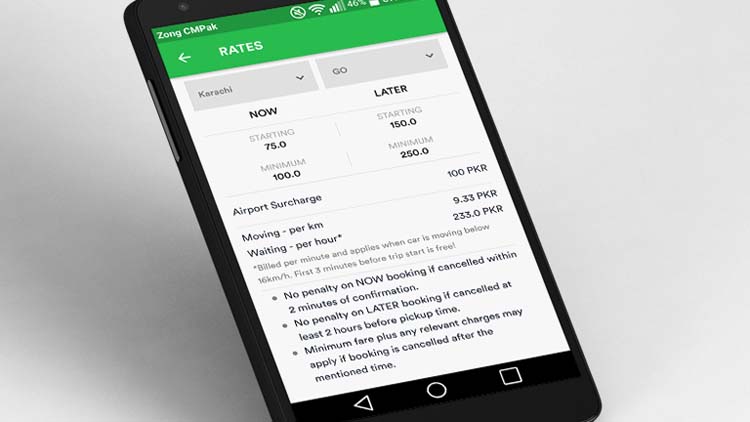We confidently say that Uber has revolutionized taxi services since in 2009. Today, Uber is the most famous and known app in the whole world. It is also a successful contempt many regulative issues across the world. In 2016, it was entered in Pakistan and launching in Lahore and later expanding to Karachi. Careem in the main competitor was established in 2012 in Dubai and now developed in 6 cities of Pakistan (Lahore, Karachi, Islamabad, Hyderabad, Faisalabad, and Peshawar). If we talk about the Uber VS Careem, we say that Careem doesn’t have closely the same amount of financial muscle as Uber.
Uber VS Careem Cab a Look From Both Side And Choose
As anybody who like to get around the city in comfort, the likes of Uber and Careem have been nothing less than a blessing. Due to these services, you can see the days of standing at the edge of a street and waiting for a taxi or rickshaw becoming to an end soon. Now on-demand a car transport can now be availed with a few click on a smartphone. All this happened due to the Uber and Careem Cab. In all those cities where they perform their services, users can hail a ride from almost any corner or in front of their home. Uber operate in Karachi and Lahore, but Careem operates in Islamabad and Lahore and also in Gujranwala, Peshawar, and Faisalabad.
Let’s take a look at Uber VS Careem and analyze some of their shortcomings and advantages.
Services and Rentals

Currently, Careem offers five options for the user like Business, Go+, Lower Go+, Go, and Lower Go cars. Careem charge at least 80 rupees for Go and a basic fare is Rs. 80 as well the variable fare is Rs. 7.4/kilometer. The ticket for the Go+, minimum charges are Rs. 144 whereas for business cars, minimum charges is Rs. 200.
Uber provides two services for travelers like cars and rickshaw. Rickshaw charges of Uber are Rs. 35 and basic is Rs. 3/kilometer. The minimum charges are Rs.100, and variable fare stands at Rs. 9.38/kilometer. According to my view, Uber is much better for vendors and car owner as well as for customer whereas Careem tries to compete Uber and lower down its rate to follow Uber but they are failed to do so, their services are not as good as Uber.
How Much Can you Earn from Careem and Uber?
I had worked with both companies Careem and Uber for about 12 months and then sell my car.
If you have a car which fulfills the requirements set by Careem or Uber, you can earn up to and around 27–30,000 in a month after covering all your costs for that month.
Revenue Head
- Daily cash collection
- Bonuses
The additions of above amount to around 90,000 to 105,000. You can earn 3500 per day working at least 15-17 hours daily, a hard job actually, they down their rates as lower than a rickshaw.
Cost head
- Fuel (45,000)
- Driver’s salary (18000)
- Car maintenance (8–15,000)
Total amounts to a maximum of 78,000.
Calculation
Revenue – Cost = profit
105000–78,000 = 27,000 pkr.
Result
If you have a bad car, in other words, you can say a car worth of 500000, then it’s good to register your car in Careem or Uber because you know you have not the new car then you’ll be able to get 27K per month a profit. Don’t try to buy a brand new car or getting a car on leasing, if you do this you’ll kill yourself, I’ve done the same mistake and then I had sold my car with a great loss.
How Are Safe Both?
Both companies are just like in a taxi and a stranger driving the car. So, that’s why the issue of safety is of prime concern. Uber and Careem are taking precautions in this regard, when it comes to signing drivers, to guarantee the safety of their travelers. It is reality Uber service has faced condemnation in some parts of the world due to the cases of sexual assault comprising drivers and travelers. This is the primary reason why women in Pakistan prefer to travel with Careem’s service.
How many Services Affect Pakistanis
Both services are relatively new for Pakistanis. They are sure to reduce public transport despairs by a considerable margin and mark the end of rent-a-car business and traditional taxi in the long run.
As a smartphone penetration increases, rickshaw, and taxi drivers that free-for-all to espouse new technologies may find themselves in anxiety. Uber and Careem services are immensely popular in such a short time and are widely used by employed person, young man, and student who are most likely to be smartphone users. Both are concentrating more on demographic, in the hope of positive reviews and experiences that translate to rapid growth in the coming future. It is likely that both services face resistance and repercussion from local transport unions whose businesses could be adversely affected.

